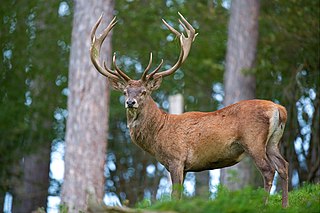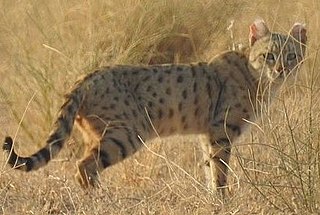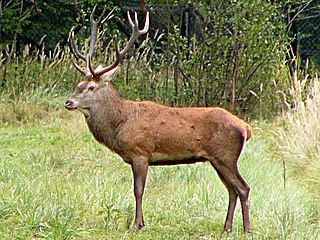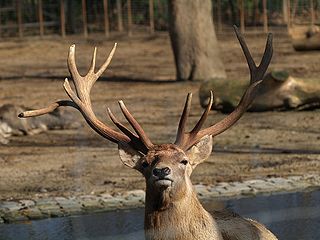
The sika deer, also known as the Northernspotted deer or the Japanese deer, is a species of deer native to much of East Asia and introduced to other parts of the world. Previously found from northern Vietnam in the south to the Russian Far East in the north, it is an uncommon species that has been extirpated in most areas of its native range, except in Japan, where it is overabundant and present in very large numbers.

The Tarim River, known in Sanskrit as the Śītā, is an endorheic river in Xinjiang, China. It is the principal river of the Tarim Basin, a desert region of Central Asia between the Tian Shan and Kunlun Mountains. The river historically terminated at Lop Nur, but today reaches no further than Taitema Lake before drying out.

The red deer is one of the largest deer species. A male red deer is called a stag or hart, and a female is called a hind. The red deer inhabits most of Europe, the Caucasus Mountains region, Anatolia, Iran, and parts of western Asia. It also inhabits the Atlas Mountains of Northern Africa; being the only living species of deer to inhabit Africa. Red deer have been introduced to other areas, including Australia, New Zealand, the United States, Canada, Peru, Uruguay, Chile and Argentina. In many parts of the world, the meat (venison) from red deer is used as a food source.

The Caspian tiger was a Panthera tigris tigris population native to eastern Turkey, northern Iran, Mesopotamia, the Caucasus around the Caspian Sea, Central Asia to northern Afghanistan and the Xinjiang region in western China. Until the Middle Ages, it was also present in southern Russia. It inhabited sparse forests and riverine corridors in this region until the 1970s. This population was regarded as a distinct subspecies and assessed as extinct in 2003.
There are various kinds of Xinjiang coins produced throughout the history of Xinjiang using the styles of contemporary Chinese cash coins as well as Persian and Islamic coinages. As not many records exist from the ancient monarchies of Xinjiang the study of its coinage has determined when which rules reigned and the state of the economy based on metallurgical analyses.

The Tarim mummies are a series of mummies discovered in the Tarim Basin in present-day Xinjiang, China, which date from 1800 BCE to the first centuries BCE, with a new group of individuals recently dated to between c. 2100 and 1700 BCE. The Tarim population to which the earliest mummies belonged was agropastoral, and they lived circa 2000 BCE in what was formerly a freshwater environment, which has now become desertified.

The Yarkand River is a river in the Xinjiang Uyghur Autonomous Region of western China. It originates in the Siachen Muztagh in a part of the Karakoram range and flows into the Tarim River or Neinejoung River, with which it is sometimes identified. However, in modern times, the Yarkand river drains into the Midstream Reservoir and exhausts its supply without reaching the Tarim river. The Yarkand River is approximately 1,332.25 km (827.82 mi) in length, with an average discharge of 210 m3/s (7,400 cu ft/s).

Muztagh Ata or Muztagata is the second highest of the mountains which form the northern edge of the Tibetan Plateau in China. It is sometimes regarded as being part of the Kunlun Mountains, although physically it is more closely connected to the Pamirs. It is also one of the relatively easier 7,000 m peaks in the world to climb, due to its gentle western slope and the comparatively drier weather of Xinjiang, though a thorough acclimatization period and a very strong physical condition are crucial for success.

The Tarim Basin deciduous forests and steppe is a temperate broadleaf and mixed forests ecoregion in the Xinjiang Uyghur Autonomous Region of western China. The ecoregion includes deciduous riparian forests and steppes sustained by the region's rivers in an otherwise arid region.

The Asiatic wildcat, also known as the Asian steppe wildcat and the Indian desert cat, is an African wildcat subspecies that occurs from the eastern Caspian Sea north to Kazakhstan, into western India, western China and southern Mongolia. There is no information on current status or population numbers across the Asiatic wildcat's range as a whole, but populations are thought to be declining.

Cervus is a genus of deer that primarily are native to Eurasia, although one species occurs in northern Africa and another in North America. In addition to the species presently placed in this genus, it has included a whole range of other species now commonly placed in other genera. Additionally, the species-level taxonomy is in a state of flux.

The Kashmir stag, also called hangul, is a subspecies of Central Asian red deer endemic to Kashmir and surrounding areas. It is found in dense riverine forests in the high valleys and mountains of Jammu and Kashmir and northern Himachal Pradesh. In Kashmir, it is found primarily in the Dachigam National Park where it receives protection, and elsewhere it is more at risk. In the 1941s, the population was between 3000 and 5000 individuals, but since then habitat destruction, over-grazing by domestic livestock and poaching have reduced population dramatically. Earlier believed to be a subspecies of red deer, a number of mitochondrial DNA genetic studies later had the hangul as a part of the Asian clade of the elk. The IUCN and American Society of Mammalogists, however, include it in the new grouping of Central Asian red deer, with the Kashmir stag being the type subspecies. The 2008 census counted 160 mature individuals in the Kashmir valley and northern Chamba in Himachal Pradesh. According to the census in 2019, there were only 237 hanguls. According to 2023 census, the numbers have improved to 289.

The Bactrian deer, also called the Bukhara deer, Bokhara deer, or Bactrian wapiti, is a lowland subspecies of Central Asian red deer native to Central Asia. It is similar in ecology to the related Yarkand deer in that it occupies riparian corridors surrounded by deserts. The subspecies are separated from one another by the Tian Shan Mountains and probably form a primordial subgroup of the red deer.

The Tibetan red deer also known as shou, is a subspecies of elk/wapiti native to the southern Tibetan highlands and Bhutan. Once believed to be near-extinct, its population has increased to over 8,300, the majority of which live in a 120,000-hectare nature reserve established in 1993 in Riwoqê County, Qamdo Prefecture, Tibet Autonomous Region, China. Some have been kept at the beginning of the 20th century in London, and in a small zoo south of Lhasa.

The Central Asian red deer, also known as the Tarim red deer is a deer species native to Central Asia, where it used to be widely distributed, but is scattered today with small population units in several countries. It has been listed as Least Concern on the IUCN Red List since 2017. It was first described in the mid-19th century.

The Eurasian Steppe, also simply called the Great Steppe or the steppes, is the vast steppe ecoregion of Eurasia in the temperate grasslands, savannas and shrublands biome. It stretches through Hungary, Bulgaria, Romania, Moldova, Ukraine, western Russia, Siberia, Kazakhstan, Xinjiang, Mongolia and Manchuria, with one major exclave, the Pannonian steppe, located mostly in Hungary.

The Yarkand hare is a species of mammal in the family Leporidae. It has soft, straight, sandy brown dorsal pelage which has grayish-black stripes, and completely white ventral pelage. Endemic to China, the Yarkand hare is restricted to the Tarim Basin in Southern Xinjiang, China. It is mainly nocturnal, and forages on grass and crops. The female produces two or three litters annually, each consisting of two to five young. It is rated as near threatened on the International Union for Conservation of Nature Red List of Endangered Species and by the Red List of China's Vertebrates. However, Chinese geneticists have stated the species is "endangered" due to limited habitat and its fragmentation, and over-hunting and poaching.
The Barandabhar forest covers an area of 87.9 km2 and bisects the Chitwan District in east and west Chitwan. Barandabhar, a 29 km long forest patch, is bisected by the Mahendra Highway, resulting in a 56.9 km2 area in the buffer zone of RCNP and 31 km2 is under the district forest office.















